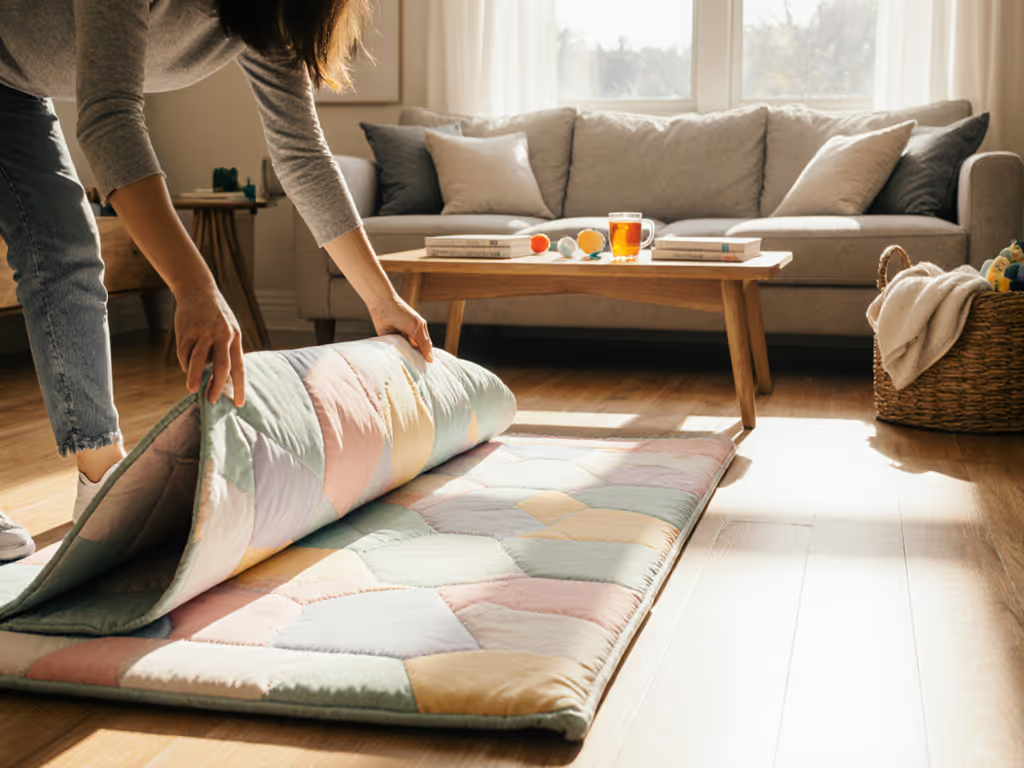
Crawling Mat Explained: Safe Play from Infancy Onward
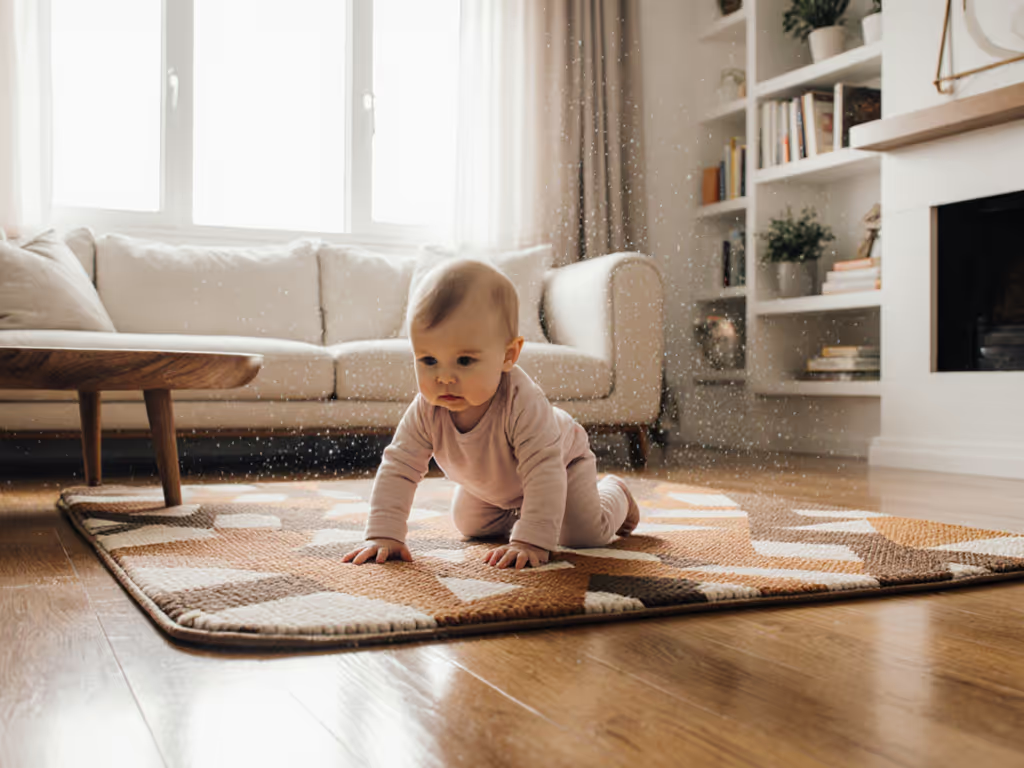
Did you know that over 90 percent of babies hit key motor milestones sooner when given a dedicated safe space for movement? Early exploration lays the groundwork for strength, confidence, and brain development. Parents searching for ways to encourage crawling and first steps often discover the difference a well-designed surface makes. With the right knowledge, you can create a secure, comfortable play area that helps your child thrive while giving you peace of mind.
Key Takeaways
| Point | Details |
|---|---|
| Crawling Mats as Development Tools | Crawling mats provide a safe environment for infants to explore, promoting motor skill development and confidence during physical activities. |
| Material Varieties and Their Benefits | Different materials (PVC, EPE, XPE) offer unique features, such as cushioning levels and portability, which should be considered based on individual needs. |
| Importance of Safety Certifications | Parents should prioritize mats that have rigorous safety certifications to ensure they meet health and safety standards for infants. |
| Risks of Alternatives | Traditional carpets and rugs may not provide sufficient support or hygiene compared to specialized crawling mats, possibly compromising child safety and development. |
What Is a Crawling Mat? Essential Definition
A crawling mat is a specialized protective surface designed specifically for infant exploration and motor skill development. Think of it as a safe playground within your home where your little one can roll, scoot, and eventually crawl without worry. These mats transform ordinary floor spaces into cushioned, baby-friendly zones that support critical developmental milestones.
Typically constructed from high-performance materials like polyvinyl chloride (PVC), expandable polyethylene (EPE), or chemically crosslinked polyethylene foam (XPE), crawling mats provide a critical barrier between your baby and hard, potentially unforgiving surfaces. Their primary purpose goes far beyond simple floor covering - they're strategic developmental tools that create a controlled environment for physical learning.
 Key features of these mats include:
Key features of these mats include:
- Shock-absorbing cushioning to prevent injury during falls
- Soft, comfortable textures that encourage movement
- Non-slip surfaces to support early mobility attempts
- Easy-to-clean materials for practical home use
Beyond physical protection, crawling mats serve as crucial developmental spaces where infants begin exploring their world. They offer a clean, designated area that supports motor skill progression from initial rolling stages through early walking attempts. Parents appreciate these mats as safe zones where babies can practice movement without constant direct supervision, fostering independence while maintaining a secure environment. Each tumble and wiggle becomes a learning opportunity, cushioned by thoughtfully designed protective surfaces.
Types of Crawling Mats and Key Differences
Crawling mats aren't a one-size-fits-all solution. Material composition is the primary factor distinguishing different types, with each offering unique advantages for infant play and development. Parents navigating this landscape will encounter three primary mat materials: polyvinyl chloride (PVC), expandable polyethylene (EPE), and chemically crosslinked polyethylene foam (XPE).
Each mat material brings distinct characteristics to the table. PVC mats are typically budget-friendly and water-resistant, making them easy to clean and maintain. EPE mats offer excellent shock absorption and lightweight construction, ideal for families who want portability. XPE mats represent the premium option, featuring superior cushioning, non-toxic properties, and enhanced durability. Key differences include:
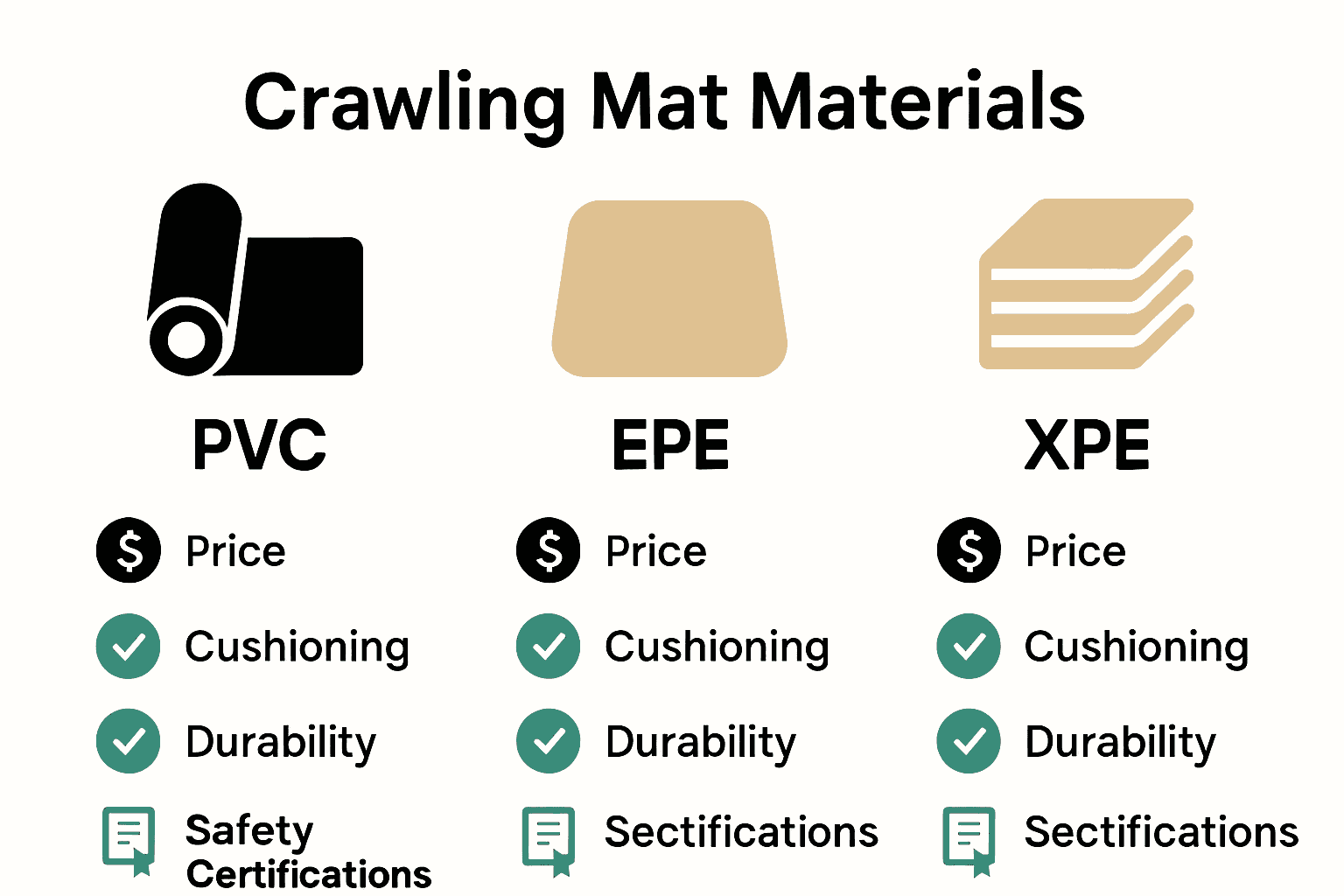
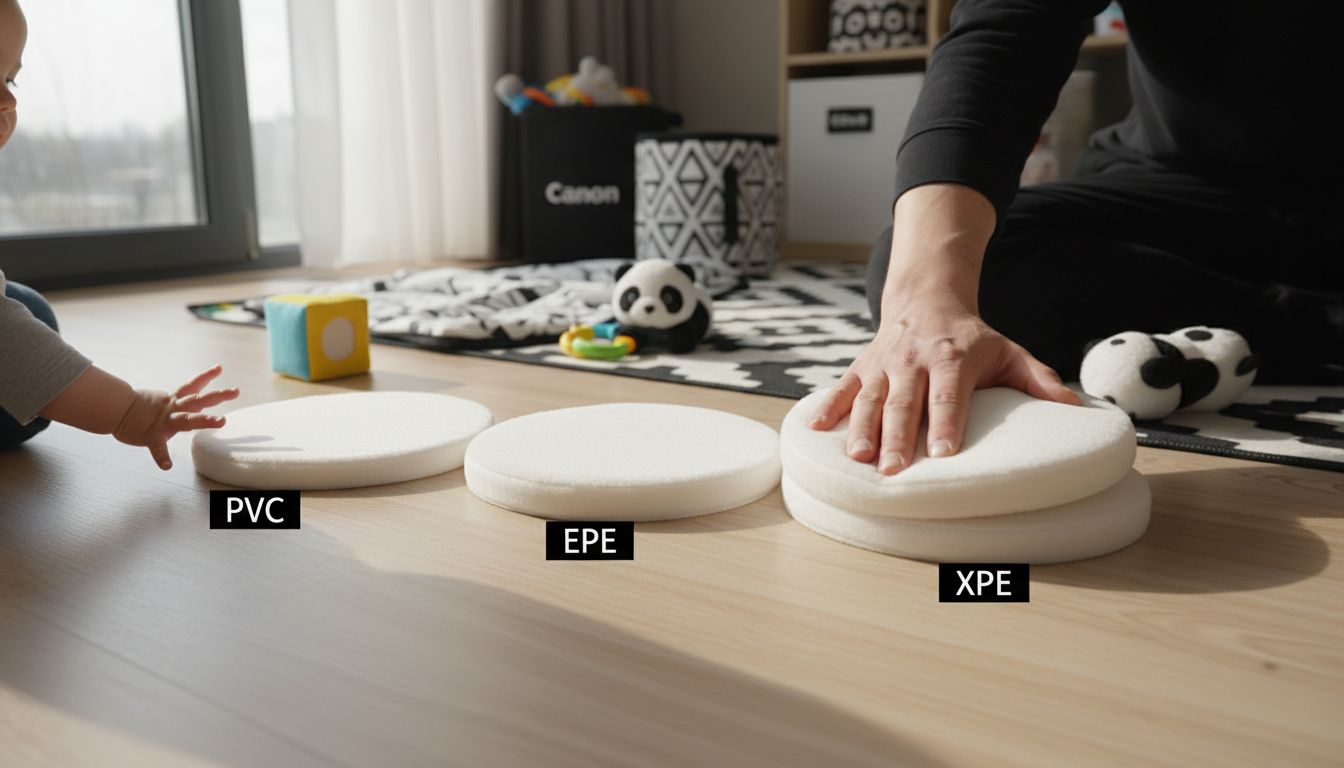
Here's a comparison of the primary crawling mat materials and their features:
| Feature | PVC | EPE | XPE |
|---|---|---|---|
| Price | Budget-friendly | Moderate | Premium |
| Cushioning | Moderate | Excellent | Superior |
| Portability | Moderate | Lightweight | Lightweight |
| Cleaning | Easy | Easy | Easy |
| Toxic-Free | Sometimes | Often | Yes (non-toxic) |
| Durability | Good | Good | Very High |
| Water Resistance | Yes | Yes | Yes |
| Thickness Range | 4-12mm | 8-15mm | 10-15mm |
| Safety Certifications | Varies | Varies | Commonly certified |
- Thickness variations (ranging from 4mm to 15mm)
- Impact absorption capabilities
- Temperature resistance
- Longevity and wear performance
- Ease of cleaning and maintenance
Beyond material, crawling mats differentiate themselves through design features like interlocking panels, reversible surfaces, and specialized textural elements that stimulate infant sensory exploration. Some advanced mats incorporate educational prints, activity zones, or developmental visual patterns that engage babies during playtime. When selecting a mat, parents should prioritize safety certifications, non-toxic material guarantees, and age-appropriate design elements that support their child's specific developmental stage and movement capabilities.
Core Features and Child Development Benefits
Crawling mats are more than just protective surfaces - they're strategic developmental tools designed to support critical early childhood growth stages. Physical development takes center stage, with these mats providing a dedicated space where infants can safely explore, practice motor skills, and build strength without parental anxiety about potential injuries.
The core features of crawling mats directly translate into significant developmental advantages. Cushioned surfaces encourage movement by reducing fear of falling, while textured designs stimulate sensory exploration and muscle coordination. Key developmental benefits include:
- Muscle strength building through unrestricted movement
- Enhanced spatial awareness and balance
- Sensory stimulation through varied surface textures
- Confidence building during early mobility stages
- Cognitive development through independent exploration
Beyond physical benefits, crawling mats create a controlled environment that supports holistic child development. They define a safe, hygienic play space that allows babies to transition from stationary positions to active mobility. By providing a consistent, comfortable surface, these mats become critical tools in helping infants understand movement, develop proprioception, and gain the confidence needed to progress through crucial developmental milestones. Each inch of movement becomes a learning opportunity, cushioned and supported by thoughtfully designed protective surfaces.
International Safety Standards and Certifications
Ensuring the safety of crawling mats goes far beyond visual appeal - it requires rigorous international safety certifications that protect infants from potential hazards. Parents must become savvy investigators, understanding the complex landscape of safety standards that guarantee a mat's quality and child-friendliness.
Global safety certifications serve as critical indicators of a crawling mat's compliance with stringent health and safety requirements. Different regions mandate specific testing protocols, creating a comprehensive framework for infant product safety. Key certifications parents should look for include:
- CPSIA (Consumer Product Safety Improvement Act): US standard for child product safety
- EN71-3: European standard testing for heavy metal content
- JIS S 1101:2015: Japanese safety and quality certification
- California Prop 65: Additional chemical safety requirements
Beyond official certifications, parents should scrutinize specific material safety attributes. This means verifying that crawling mats are free from dangerous compounds like BPA, phthalates, lead, and toxic PVC. Reputable manufacturers will transparently provide documentation proving their products meet these rigorous standards, offering parents peace of mind that their infant's play environment is not just comfortable, but scientifically validated as safe. The best crawling mats transform from simple floor coverings into carefully engineered protective spaces designed with meticulous attention to child well-being.
Risks, Alternatives, and Mistakes to Avoid
Navigating the world of crawling mats isn't just about selecting a cute design - it's about understanding potential hidden risks that could compromise your infant's safety. Parents must be vigilant, recognizing that not all play surfaces are created equal, and some alternatives can pose unexpected challenges to child development and safety.
Certain mistakes can transform a well-intentioned safety solution into a potential hazard. Critical risks to avoid include selecting mats with toxic materials, insufficient thickness, or lacking essential safety features. Key potential pitfalls parents should watch for are:
- Mats made from non-certified, potentially harmful materials
- Insufficient cushioning that fails to protect against impact
- Surfaces without proper anti-slip properties
- Mats that are difficult to clean and maintain hygienically
- Products lacking recognized safety certifications
Alternative surfaces like traditional carpets or area rugs might seem convenient, but they often fall short of specialized crawling mats. These alternatives can harbor allergens, provide inconsistent cushioning, and lack the targeted developmental support that purpose-built crawling mats provide. Smart parents understand that investing in a high-quality, safety-certified crawling mat isn't an expense - it's a critical investment in their child's early physical and cognitive development. The right mat becomes more than a surface; it's a carefully designed learning environment that supports safe, confident exploration.
Discover the Perfect Crawling Mat for Your Baby's Safe Play and Growth
Choosing the right crawling mat is more than just picking a floor cover. It's about creating a safe, cushioned space where your infant can build confidence, explore freely, and develop essential motor skills without the risk of injury from hard surfaces or toxic materials. You want a mat that combines shock-absorbing cushioning, non-slip safety, and trusted international safety certifications to protect your little explorer every step of the way.
At FloorBloom, we understand these concerns deeply. Our collection of beautiful, long-lasting play mats is designed to meet the highest safety standards and support your child’s growth from newborn rolls to active toddler moves. Each mat undergoes rigorous, transparent testing so you can trust it keeps harmful chemicals like BPA and phthalates away. Ready to invest in a mat that truly fits your home and provides a secure play environment? Explore our site, learn more about mat features, and take the next step toward safer play spaces today. Visit FloorBloom landing page now to find your perfect match and start giving your child the gift of safe, confident movement.
Frequently Asked Questions
What materials are crawling mats made from?
Crawling mats are typically made from high-performance materials, including polyvinyl chloride (PVC), expandable polyethylene (EPE), and chemically crosslinked polyethylene foam (XPE). Each material has unique characteristics, such as cushioning levels and safety features.
What are the key benefits of using a crawling mat for infants?
Crawling mats provide a safe, cushioned environment for infants to explore and develop motor skills. They support physical development by encouraging movement, enhancing spatial awareness, and stimulating sensory exploration without the worry of injury from hard surfaces.
How do I choose the right crawling mat for my baby?
When selecting a crawling mat, consider factors such as material safety certifications, thickness for cushioning, portability, ease of cleaning, and age-appropriate design. Also, look for non-toxic guarantees and features that support your child’s developmental stage.
What safety certifications should I look for in a crawling mat?
Key safety certifications for crawling mats include CPSIA for child product safety, EN71-3 for heavy metal content, and California Prop 65 for chemical safety requirements. These certifications ensure that the mat meets stringent health and safety standards suitable for infants.
Related Articles

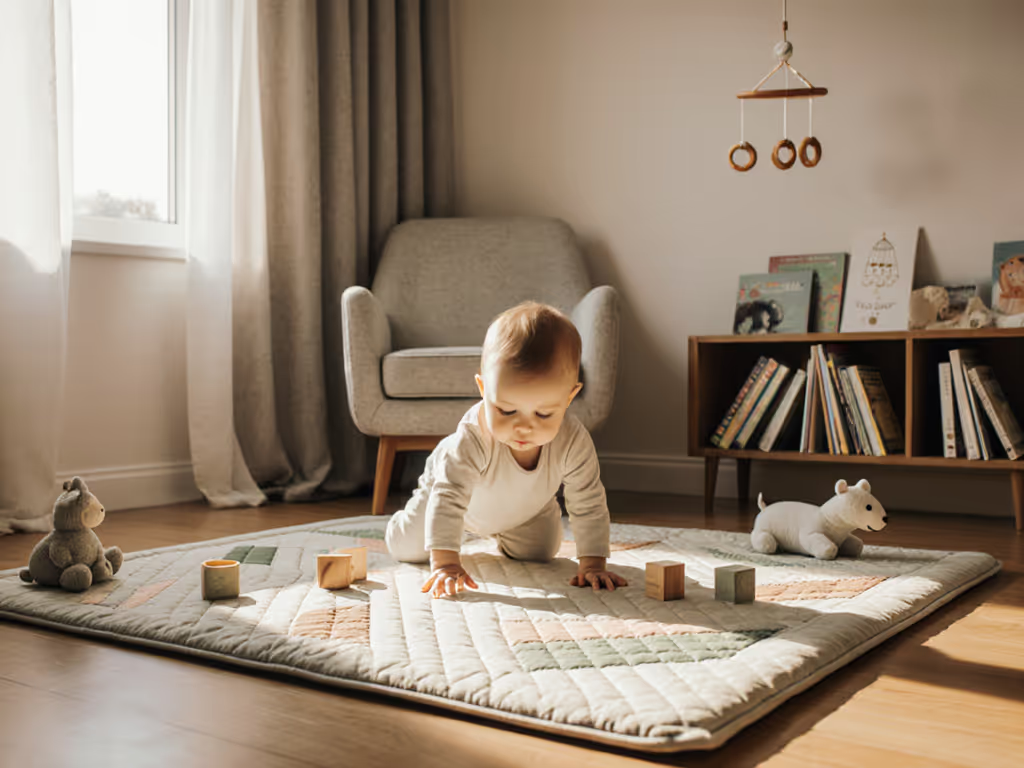
Best Play Mats for Crawling Infants – Expert Comparison 2025
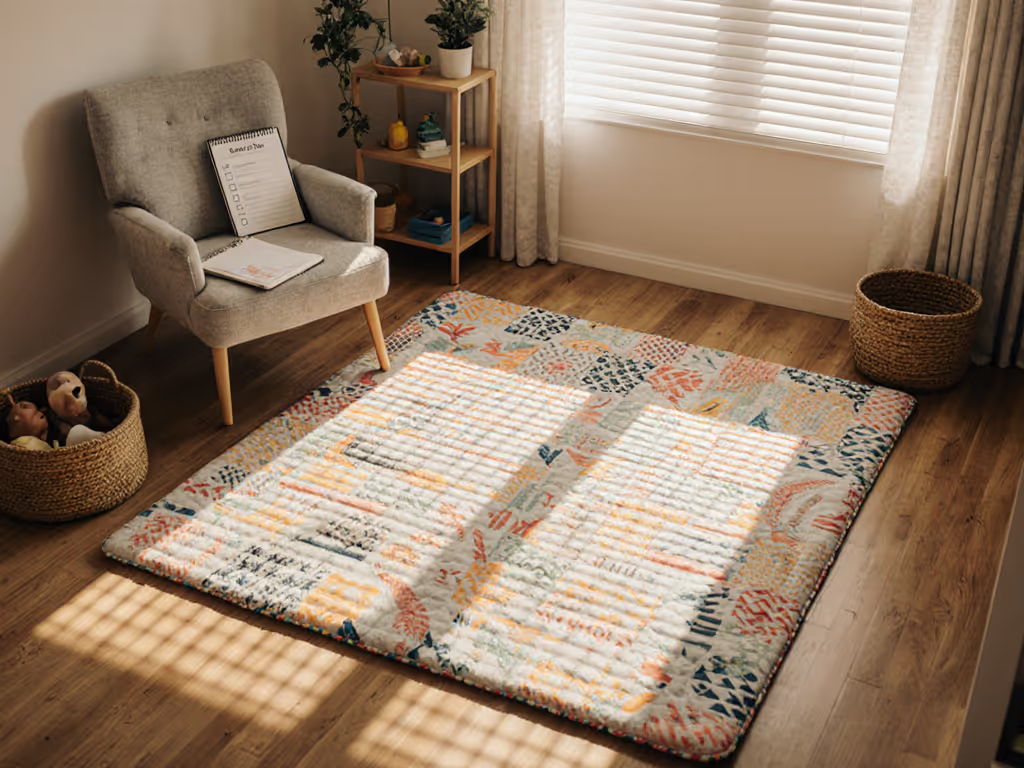
Guide to Baby Play Mats: Choose, Set Up, and Ensure Safety

The Essential Guide to Why Use Play Mats
